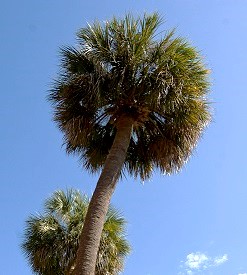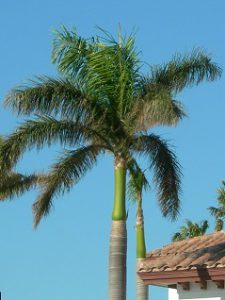By Christine Kelly-Begazo, Indian River County Agriculture Extension Agent
Pruning palm trees seems like a simple enough endeavor, but we may instinctively get a bit too excited with those pruning tools. It’s no mistake that we all favor the sight of a beautiful palm with healthy green fronds and less of the brown, decaying ones. What we sometimes don’t realize though, is that what’s best for the health of the tree may not be what we judge as palm perfection.


For the most part, if planted in the right spot, palms don’t require much help from us to keep themselves healthy. Where they run into problems is mainly with nutrient deficiencies that can attract pests and diseases. A healthy palm should have a nice, full, rounded crown with plenty of green fronds. Never remove any fronds above the horizon of three to nine (on a clock). Some people enjoy the look of a “feather duster” cut on their palms, but this is not beneficial to the plant and can, in fact, cause several problems. Pruning green, healthy leaves just to satisfy a visual preference will reduce the photosynthetic capacity of the palm which limits its ability to produce food for itself. This can lead to smaller leaves and a thinner, weaker trunk that can be susceptible to breakage during high winds. There is also a mistaken belief that closely trimmed palm canopies (also known as hurricane cuts) are safer in high wind storms, such as during a hurricane, but the opposite is actually true. The main growing point of a palm is the center bud where new fronds develop and emerge. The more fronds that circle the center of the palm the better, buffering new growth from battering winds.

Did you know that not all palms even require pruning? Does your palm have a crown shaft? You know, one of those smooth green sections at the top of the trunk like a royal palm. It’s actually several leaves tightly bound together but something else you may not know is that any palm with a crown shaft does not require ANY pruning. How easy it that? Over-pruning can also lead to pest infestations for certain palms. Canary island date palm leaves will release a volatile chemical compound when cut at their base. Guess what the compound attracts? Palm weevils, which are a living nightmare for this species of palm and any owner of one. Palms are physiologically more like grasses than like trees and any injury to the trunk can be an entry way for pests and diseases. Care must be taken not to damage the trunk and to keep pruning to a minimum.
Now you may be wondering “So what about all the dead brown leaves? Can I cut them away or not?”. It’s a good question and like any good question, it depends on some important factors. Pruning completely dead leaves as well as removing fruit stalks and flowers from the palm should never cause problems. However, it may be a good idea to observe the dead leaves on your palms to make certain determinations about its’ health. For example, if leaves brown and stay attached to the tree for months it might be a sign that the tree is deficient in potassium (K). Dead fronds shouldn’t hang around that long and normally will fall off by themselves or with slight tugging. Dead fronds that do not come off easily might be K-deficient and cutting them off will force the tree to start draining potassium from the next available (healthy) leaf. Let the deficient leaf linger for as long as it can while applying the proper fertilizer to give the palm a better fighting chance.
We must also be mindful of unintentionally spreading diseases during our landscaping endeavors. There are some pests and diseases affecting palms that can be spread using your household tools. Most of these diseases can leave fungal bodies or disease-causing residues on the tools and when new leaves are cut, the disease is transferred to the next palm. Dodge this by cleaning your tools after using them in the landscape and dipping them in a 10% disinfectant solution, such as bleach, before using them again. Antibacterial wipes can also be used to sanitize home tools but does not work well for professionals and all tools need to be cleaned thoroughly first. Pruning tools must also be sharpened in order to make a clean cut with no ragged edges.
Hopefully this short run-down of palm pruning do’s and don’ts will make you think twice (or at least think more) about the effects of pruning on palms. The best thing to do is correctly identify the species of your palm, know its maintenance needs, what diseases it’s prone to and what kinds of pests like to snack on it. This knowledge will help you determine how to safely and elegantly prune your palm, and if you still run into problems at least you can tackle them with sharp tools AND a sharp mind.
For more information about pruning palms correctly, please see:
Pruning Palms by Dr. Timoth Broschat http://edis.ifas.ufl.edu/ep443
Pruning Shade Trees in the Landscape: Pruning Palms by Dr. Ed Gilman https://hort.ifas.ufl.edu/woody/documents/palms.pdf
 0
0
